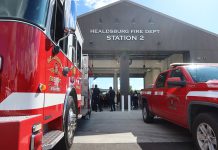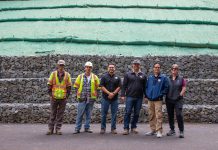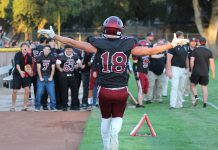The first plane to take to the New York City skies on the day of
the 9/11 attacks has landed in a Pacific Coast Air Museum
exhibit.
“It’s the only exhibit of its kind in the country. No one has
the first F-15 to respond to 9/11—that flew over the burning trade
towers—but us,” said Dave Pinsky, Executive Director of PCAM.
The $200,000 exhibit, which was professionally designed and
installed to showcase the F-15A Eagle, will debut at a ceremony on
the tenth anniversary of the attacks. The 2 p.m. ceremony will take
place at PCAM, and is free and open to the public. It will include
flyovers as well as a gathering of local servicemen and women.
“Our goals are to honor those who responded, to honor those who
fell, and to tell the unknown story of the heroism in the skies by
Air Force pilots, and on the ground by Air Force and FAA
controllers,” Pinsky said.
“We’re going to tell a story that hasn’t been told before: what
was happening in the skies above New York City that day.”
The F-15A, which was stationed in Cape Cod and flew over New
York City, came to Sonoma County by way of Tucson. How it ended up
at PCAM is the story of persistence—and a little bit of luck.
Pinsky, since becoming the Executive Director of PCAM more than
six years ago, had his heart set on becoming certified by the
National Museum of the US Air Force: a designation that would
enable the museum to house high-profile artifacts like the
F-15A.
Very few civilian museums are Air Force certified, but that
didn’t stop Pinsky, who has a hard time quitting.
“I’m supposed to be retired from two careers, but aviation gets
in your blood, and these volunteers get in your blood, too,” Pinsky
said.
So he hosted Air Force museum officials at PCAM, and wooed
them.
“They were very impressed with how we restore and maintain our
artifacts, and how we tell stories with our storyboards,” Pinsky
said. “Three years ago last month, we got the magic phone call that
we’d been approved by the Air Force museum.”
This enabled Pinsky to begin petitioning them for an
F-15—although he had no idea then which plane he might end up
with.
“High on our list of aircraft that we wanted on loan was an
F-15. We weren’t first on the list for this one, but the other
museum ahead of us didn’t have the funds—you have to pay to
disassemble and reassemble it—or the space to house it,” Pinsky
said.
Once PCAM rose to the top of the list, the Air Force museum gave
them the tail number of the plane. It was then that Pinsky realized
that the plane wasn’t just any F-15, but the first F-15 to respond
to the 9/11 attacks.
“They told us, we think that your museum can house this, and
take good care of it, and tell the story,” Pinsky said. “The Air
Force museum’s motto is ‘We are the keepers of their stories,’ and
I love that.”
So far, Pinsky has spent $127,000 on the exhibit, but has only
received $84,000 in donations.
“I have to be honest, fundraising has not gone all that well,”
Pinsky said.
Pinsky’s fundraising received a boost when Hattie Stone, a local
World War II Navy veteran, gifted $50,000 to the project. Money was
also collected at the recent air show, but there is still a long
way to go.
It will cost another $10,000 to finish the outdoor exhibit, and
Pinsky hopes to install a $70,000 multimedia exhibit inside the
museum, to better tell the September 11 story.
“We try to raise money in every way we can. But it’s been
difficult to raise money, and I don’t understand why. 9/11 was our
Pearl Harbor. In 1944, our country was attacked, and we were
attacked in 2001,” Pinsky said.
The exhibit, Pinsky noted, is perfectly in line with the
non-profit’s mission: to restore, preserve, and display artifacts;
to preserve aviation history; and to provide education for the
community, especially for young people.
“It’s a passion for us because we think we owe it to the people
who perished and the people who responded on 9/11.”
And Pinsky believes that the exhibit—and its debut this
September 11—will forever change the museum.
“I think it’s going to be the single most important day in the
history of the Pacific Coast Air Museum,” Pinsky said.








